Ultrastructure and molecular phylogenetic position of a novel euglenozoan with extrusive episymbiotic bacteria: Bihospites bacati n. gen. et sp. (Symbiontida)
- PMID: 20482870
- PMCID: PMC2881021
- DOI: 10.1186/1471-2180-10-145
Ultrastructure and molecular phylogenetic position of a novel euglenozoan with extrusive episymbiotic bacteria: Bihospites bacati n. gen. et sp. (Symbiontida)
Abstract
Background: Poorly understood but highly diverse microbial communities exist within anoxic and oxygen-depleted marine sediments. These communities often harbour single-celled eukaryotes that form symbiotic associations with different prokaryotes. During low tides in South-western British Columbia, Canada, vast areas of marine sand become exposed, forming tidal pools. Oxygen-depleted sediments within these pools are distinctively black at only 2-3 cm depth; these layers contain a rich variety of microorganisms, many of which are undescribed. We discovered and characterized a novel (uncultivated) lineage of heterotrophic euglenozoan within these environments using light microscopy, scanning and transmission electron microscopy, serial sectioning and ultrastructural reconstruction, and molecular phylogenetic analyses of small subunit rDNA sequences.
Results: Bihospites bacati n. gen. et sp. is a biflagellated microbial eukaryote that lives within low-oxygen intertidal sands and dies within a few hours of exposure to atmospheric oxygen. The cells are enveloped by two different prokaryotic episymbionts: (1) rod-shaped bacteria and (2) longitudinal strings of spherical bacteria, capable of ejecting an internal, tightly wound thread. Ultrastructural data showed that B. bacati possesses all of the euglenozoan synapomorphies. Moreover, phylogenetic analyses of SSU rDNA sequences demonstrated that B. bacati groups strongly with the Symbiontida: a newly established subclade within the Euglenozoa that includes Calkinsia aureus and other unidentified organisms living in low-oxygen sediments. B. bacati also possessed novel features, such as a compact C-shaped rod apparatus encircling the nucleus, a cytostomal funnel and a distinctive cell surface organization reminiscent of the pellicle strips in phagotrophic euglenids.
Conclusions: We characterized the ultrastructure and molecular phylogenetic position of B. bacati n. gen. et sp. Molecular phylogenetic analyses demonstrated that this species belongs to the Euglenozoa and currently branches as the earliest diverging member of the Symbiontida. This is concordant with ultrastructural features of B. bacati that are intermediate between C. aureus and phagotrophic euglenids, indicating that the most recent ancestor of the Symbiontida descended from phagotrophic euglenids. Additionally, the extrusive episymbionts in B. bacati are strikingly similar to so-called "epixenosomes", prokaryotes previously described in a ciliate species and identified as members of the Verrucomicrobia. These parallel symbioses increase the comparative context for understanding the origin(s) of extrusive organelles in eukaryotes and underscores how little we know about the symbiotic communities of marine benthic environments.
Figures

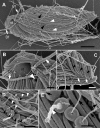


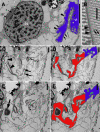
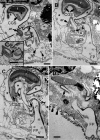

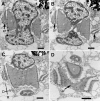


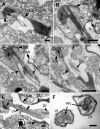

Similar articles
-
Identity of epibiotic bacteria on symbiontid euglenozoans in O2-depleted marine sediments: evidence for symbiont and host co-evolution.ISME J. 2011 Feb;5(2):231-43. doi: 10.1038/ismej.2010.121. Epub 2010 Aug 5. ISME J. 2011. PMID: 20686514 Free PMC article.
-
Euglenozoa: taxonomy, diversity and ecology, symbioses and viruses.Open Biol. 2021 Mar;11(3):200407. doi: 10.1098/rsob.200407. Epub 2021 Mar 10. Open Biol. 2021. PMID: 33715388 Free PMC article. Review.
-
Ultrastructure and molecular phylogeny of Calkinsia aureus: cellular identity of a novel clade of deep-sea euglenozoans with epibiotic bacteria.BMC Microbiol. 2009 Jan 27;9:16. doi: 10.1186/1471-2180-9-16. BMC Microbiol. 2009. PMID: 19173734 Free PMC article.
-
Reconstruction of the feeding apparatus in Postgaardi mariagerensis provides evidence for character evolution within the Symbiontida (Euglenozoa).Eur J Protistol. 2013 Jan;49(1):32-9. doi: 10.1016/j.ejop.2012.07.001. Epub 2012 Aug 25. Eur J Protistol. 2013. PMID: 22925570
-
Comparative molecular cell biology of phototrophic euglenids and parasitic trypanosomatids sheds light on the ancestor of Euglenozoa.Biol Rev Camb Philos Soc. 2019 Oct;94(5):1701-1721. doi: 10.1111/brv.12523. Epub 2019 May 16. Biol Rev Camb Philos Soc. 2019. PMID: 31095885 Review.
Cited by
-
Identity of epibiotic bacteria on symbiontid euglenozoans in O2-depleted marine sediments: evidence for symbiont and host co-evolution.ISME J. 2011 Feb;5(2):231-43. doi: 10.1038/ismej.2010.121. Epub 2010 Aug 5. ISME J. 2011. PMID: 20686514 Free PMC article.
-
Euglenozoa: taxonomy, diversity and ecology, symbioses and viruses.Open Biol. 2021 Mar;11(3):200407. doi: 10.1098/rsob.200407. Epub 2021 Mar 10. Open Biol. 2021. PMID: 33715388 Free PMC article. Review.
-
Inventory and Evolution of Mitochondrion-localized Family A DNA Polymerases in Euglenozoa.Pathogens. 2020 Apr 1;9(4):257. doi: 10.3390/pathogens9040257. Pathogens. 2020. PMID: 32244644 Free PMC article.
-
Identification and Quantification of Abundant Species from Pyrosequences of 16S rRNA by Consensus Alignment.Proceedings (IEEE Int Conf Bioinformatics Biomed). 2011 Feb 4;2010:153-157. doi: 10.1109/BIBM.2010.5706555. Proceedings (IEEE Int Conf Bioinformatics Biomed). 2011. PMID: 22102981 Free PMC article.
-
Ciliary transition zone evolution and the root of the eukaryote tree: implications for opisthokont origin and classification of kingdoms Protozoa, Plantae, and Fungi.Protoplasma. 2022 May;259(3):487-593. doi: 10.1007/s00709-021-01665-7. Epub 2021 Dec 23. Protoplasma. 2022. PMID: 34940909 Free PMC article. Review.
References
-
- Triemer RE, Farmer MA. In: The Biology of Free-living Heterotrophic Flagellates. Patterson DJ, Larsen J, editor. Clarendon Press, Oxford; 1991. The ultrastructural organization of the heterotrophic euglenids and its evolutionary implications; pp. 205–217.
-
- Leander BS, Triemer RE, Farmer MA. Character evolution in heterotrophic euglenids. Eur J Protistol. 2001;37:337–356. doi: 10.1078/0932-4739-00842. - DOI
-
- Simpson AGB, Lukes J, Roger AJ. The evolutionary history of kinetoplastids and their kinetoplasts. Mol Biol Evol. 2002;19:2071–2083. - PubMed
-
- Kivic PA, Walne PL. An evaluation of the possible phylogenetic relationship between euglenophyta and kinetoplastida. Orig Life. 1984;13:269–288. doi: 10.1007/BF00927177. - DOI
Publication types
MeSH terms
Substances
Associated data
- Actions
- Actions
LinkOut - more resources
Full Text Sources

